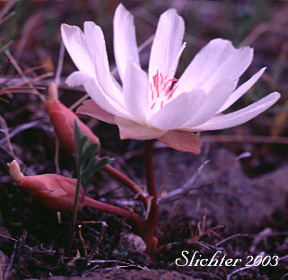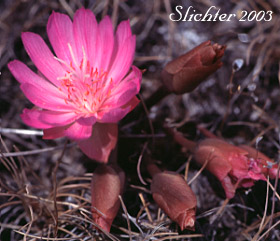 The
photo at right shows a bitterroot on rocky slopes about 3 miles south of Fields,
OR............May 27, 2000.
The
photo at right shows a bitterroot on rocky slopes about 3 miles south of Fields,
OR............May 27, 2000.
Bitterroot is a very attractive wildflower suited for dry, naturalized gardens. It is a low plant with numerous narrow leaves in a basal rosette (See photo at right.), and lacking a large flower stem with leaves. The thick, fleshy leaves appear before the flowers appear and whither as the flowers bloom. The leaves range from 1.5-5 cm long and are linear-clavate. The short, leafless stem ranges from 1-3 cm tall, and has a whorl of 5-6 linear bracts from 5-10 mm long at its tip.
The large showy flowers are variable in color, from whitish, rose, to deep pink and occasionally a light peach color. The 12-18 (usually 15) petals are oblong-oblanceolate in shape from 18-35 mm long. The 6-9 (usually 4) sepals are oval, 10-25 mm long, and often similar in color to the petals. The stamens are numerous, numbering 30-50. There may be just one flower on the stem, but more typically there are 2-3. After flowering, the sepals close around the ovary. On maturation of the seeds, the sepals and enclosed ovary as a unit tend to break free of the scape and are then blown across the ground, scattering seeds away from the parent.
The fleshy taproot, although bitter in taste, was highly prized by native Americans as a food source. Commonly it was dug as the leaves developed, at a period when they were less bitter. They were peeled and boiled, then eaten immediately or dried for later use. The bitterroot is also the state flower of Montana.
Bitterroot is suitable for use in rock gardens or in troughs, especially when used east of the Cascade Mts. I have a number of plants that have survived the numerous winter rains west of the Cascades, but they need to be planted on raised sand and gravel beds to the front of the planting, away from other plants which may overwhelm them. Some have survived out in the open all winter, while I have covered others with hoop frames covered with plastic.
 The
photo at right shows a vibrantly colored bitterroot from the Columbia Hills,
north of The Dalles, OR......June 1, 1997.
The
photo at right shows a vibrantly colored bitterroot from the Columbia Hills,
north of The Dalles, OR......June 1, 1997.
Bitterroot is found on dry, gravelly, rocky, and heavy soils from the sagebrush desert to the lower elevations of the mountains. It can take spring rainfall, and the leaves may green up in the fall, but it does not do well with too much winter (or summer) wetness.
Bitterroot may be found east of the Cascade Mts. from British Columbia south through Washington and Oregon to southern California. It is found eastward to Montana, Colorado, and Arizona.
The photo at left shows the cluster of basal leaves of the bitterroot. Photographed near the summit of Selah Butte, several miles northeast of Selah, WA in central Washington........March 28, 2007. The photo at right shows several basal leaf clusters of bitterroot as seen on scablands along the main east-west access road (Box Springs Road) at the Simcoe Mountains Unit of the Klickitat Wildlife Area........April 11, 2017.
The photo at left shows bitterroot along the Canyon Mountain Trail #218, Strawberry Mountain Wilderness.........June 21, 2011. The photo at right shows bitterroot and a friend about one mile southeast of Spanish Peak, Ochoco National Forest........June 14, 2015.
Bitterroot blooming along the Canyon Mountain Trail #218, Strawberry Mountain Wilderness.........May 29, 2014.
Bitterroot as seen left on rocky soils near the Odessa Craters, Lincoln County, Washington.........May 8, 2012. The photo at right shows bitterroot flower buds as seen at Fort Rock State Park, Lake County, Oregon.........May 18, 2016.
Bitterroot blooming along the Alder Springs Trail #855 near the trailhead, Crooked River National Grasslands........May 11, 2018.
Paul Slichter